...Best of Sicily presents... Best of Sicily Magazine. ... Dedicated to Sicilian art, culture, history, people, places and all things Sicilian. |
by L. Mendola and V. Salerno | |||||
Magazine Index Best of Sicily Arts & Culture Fashion Food & Wine History & Society About Us Travel Faqs Contact Map of Sicily
|
The Norsemen ("Viking" comes from the early Scandinavian word vikingr for "pirates") were Danish, Norwegian and Swedish adventurers who rose to power in the ninth century, raiding the coasts of northwestern Europe in places like England and Ireland, and sailing as far as North America. The Swedish element penetrated overland and along rivers into the Baltics and Russia to the Black Sea. Constantinople's Varangian Guard consisted of Vikings such as Harald Sigurdsson ("Hardrada") who fought alongside Normans with George Maniakes in Byzantine Sicily. The Vikings were initially pagans, and their colorful mythology has given us the English names of several days of the week (Wednesday for Woden, Thursday for Thor, etc.), following an earlier Roman custom of naming the days for gods (as in the Italian Mercoledì for Mercury and Giovedì for Jove or Jupiter). The Franks were a Germanic tribe which settled in Gaul (France and southern Belgium) during the decline of the Roman Empire. The Romans abandoned part of Belgium to the Franks in AD 358. By 507, much of France was united under the Christianized Frankish king Clovis. This included what is now Normandy. By 900, Vikings were raiding this region but also establishing outposts
there. In antiquity, the region of the Seine and Eure valleys had In general, the Normans of England were somewhat higher-born than their compatriots in Italy, their surnames typically based on familial fiefs in Normandy. Like the conquest of England, the Normans' conquest of Italy was characterized by social and political motivations, though it was much slower than the English campaign. The patriarchs of Rome (the popes) resented Byzantine influence in Italy, and the power of the Lombard feudatories (in peninsular Italy) was viewed as a nuisance. There were also more racist motives. Whereas the competition between Saxons and Normans for England was largely a question of Saxon English-ness versus Norman greed, the campaign against the Sicilian Arabs had all the makings of a "holy war," whether justified or not. The Papacy made it clear that restoring Sicily to Latin Christiandom (separating its Orthodox Christians from Constantinople's influence) was at least as important as reducing the influence of Islam on the island. In the event, the Normans did not Latinize Sicily rapidly enough for Papal tastes, nor did they immediately seek to convert the island's Muslims. In fact, they were often at odds with the popes. In 1054, the Church separated. The Great Schism left the Latin ("Roman")
West distinctive of the Byzantine ("Greek") East, resulting in
the churches now described as "Catholic" and "Orthodox."
In truth, the conflict had been brewing for two centuries or more, and far
transcended theology. In 1061, having assumed control of much of southern
Italy, a Norman force crossed into Sicily at Messina and seized the city
from its Saracen garrison. The Sicilian conquest now underway was slow and
difficult. In 1066, a Norman force, including some knights who had fought
in the Italian campaigns, won the Battle of Hastings (based in part on tactics
learned at Messina), establishing the Norman presence in England. London
was taken soon afterward. In Sicily, on the other hand, the de Hauteville
brothers, Robert "Guiscard" and Roger, reached Palermo only in
1071. While Saxon lords paid fealty to William "the Conqueror"
of England almost immediately, it took Roger and his knights more than a
decade following the Battle of Palermo to bring
the entire island under Norman control. (Emir Ibn Hamud of Kasr Yanni surrendered
only in 1087.) It was worth the effort. Their For all that, the Normans were not the first northern European invaders to reach Sicilian shores during the Middle Ages. That distinction belongs to the Vandals and Goths, whose rule was short-lived and left few visible traces. By contrast, vestiges of Norman Sicily are everywhere to be found. --particularly churches and castles. Sicilian society was more sophisticated than what the Normans encountered in England or even mainland Italy. The polyglot culture of the Arabs and Byzantines was a prosperous intellectual, artistic and economic environment at the center of the most important region of the "Western World" --the Mediterranean. It was a geographic crossroads between north and south, east and west. The beautiful Romanesque architectural style of Normandy (Cefalù's cathedral is based on Caen's Saint Etienne church), so important in changing the face of Saxon England, was welcome in Sicily, but it merely embellished what the Byzantines and Arabs already knew. The "Norman-Arab" style of art and architecture was unique, combining Byzantine, Moorish and northern European movements in a new expression of aesthetics. More important than this was the evolution of the social fabric of Norman Sicily, adapting essentially Arab institutions to European realities. Throughout the Norman era (roughly from1070 to 1200), ethnic and religious tolerance were generally accepted as integral parts of Sicilian society. Though there were conflicts, multicultural co-existence usually prevailed. The Church, but also the Sicilian language, was gradually Latinized. European institutions such as feudalism were introduced. In effect, Norman Sicily became part of Europe rather than Africa (under the Moors) or Asia (under the Byzantines). On a humanistic level, its multicultural orientation was important enough, but Sicily's emergence as one of Europe's most important regions ushered in a "Golden Age" which continued into the "Swabian" era (of Frederick II) during the thirteenth century. It was probably Sicily's finest hour. The twelfth century saw Sicily become a kingdom under Roger II (whose realm included not only Sicily but most of Italy south of Rome). The Norman government included clerics and from England and Normandy, great Arab thinkers such as Abdullah al-Idrisi, and a young Anglo-Norman queen. Nowadays, "New World" nations such as Canada, the United States and Australia seem to represent the epitome of tolerant, multicultural societies. In the Middle Ages, however, the concept was a novel one. True, the Roman Empire had embraced many cultures, but it could be argued that Norman Sicily supported a truer equality than most places offered, and it was more benevolent than ancient Rome. Slavery was eventually all but abolished, and serfdom was never as prevalent as it was in England, France or Germany, while freedom of speech and literacy came to be considered every Sicilian's birthright. The Normans' system of justice allowed separate --but equal-- jurisdictions based on Shari'a law for Muslims, Judaic law for Jews, Byzantine Greek law for Byzantines and Norman feudal law for Normans. Important documents were multilingual. True, a Latin (and Roman Catholic) orientation eventually prevailed, but until the reign of Frederick II a more or less egalitarian society existed. At least for a time, it was a successful experiment, and a necessary one. Despite its ethnic diversity, or perhaps because of it, Norman Sicily evolved into an enduring "nation" with Sicilians as its "people." In other Italian regions such developments were literally centuries away. (This was even true of Sardinia, which, as an island, might reasonably be expected to assume a "national" identity long before it did.) In time, the territory ruled by the Normans, contiguous to Magna Graecia, became known to Italians simply as "il Regno" ("the Kingdom"). Palermo (the Arabs' Bal'harm) was the capital of this realm and later, under Frederick II, the capital of the entire Holy Roman Empire. The period beginning with the arrival of the Normans in 1061 and ending with the death of their descendant, Frederick, in 1250, was a brief --but remarkable-- shining moment in European history. The Normans retained much of Arab society. After all, there was no need
to change certain things which functioned well. Some It is generally believed that most red-haired and blue-eyed Sicilians owe their coloring to the medieval Normans or the Lombards who often accompanied them. Yet we do not know how many Normans settled in Sicily. Most were men, most were knights or other soldiers, and many were feudatories, effectively constituting the earliest medieval Sicilian landed aristocracy. Most married Sicilian-born women. The best estimate of the Norman migration places it at fewer than eight thousand persons arriving between 1061 and 1161, but even this is highly speculative. It certainly was not a mass immigration comparable to those of the Arabs (Saracens) or ancient Greeks. The first Norman incursions into Sicily were measured in hundreds of Norman knights accompanied by greater numbers of non-Norman infantry, and not all of them remained here. Except for Benedictine and diocesan clergy, there were few men of learning among the Norman arrivals. Change did not come overnight. Some localities were more Orthodox Christian and Greek-speaking while others were predominantly Muslim and Arabic-speaking. Mosques stood alongside churches and synagogues. The Norman vassals and knights, though Christian, were Roman Catholic. It was the Normans who Latinized Sicily (just as they Latinized the language of Saxon England), both linguistically and ecclesiastically. Some isolated Orthodox monasteries in the northeast of Sicily survived this process for a time, but most of Sicily's greatest Norman churches, though boasting some superficially Byzantine elements, were founded (or re-constructed) as Latin (Roman Catholic) ones. The Norman era lasted through four rulers (two Rogers succeeded by two Williams), followed by a Swabian (German) wed to Constance, the last surviving Norman princess, in a land where --at least in theory-- only men ruled. Her son, Frederick II, could be said to have continued the Norman tradition but he was a Hohenstaufen and not a Hauteville. In the event, the "home rule" of Sicily from its own capital effectively ended with his death in the middle of the thirteenth century. Henceforth, the island was to be governed from Naples or from cities even further afield. The Sicily of the Normans represents a unique time in history which, like all such periods, was not to last forever. In the words of John Julius Norwich: "Norman Sicily stood forth in Europe --and indeed in the whole bigoted medieval world-- as an example of tolerance and enlightenment, a lesson in the respect that every man should feel for those whose blood and beliefs happen to differ from his own." About the Authors: Luigi Mendola is the History Editor of Best of Sicily and author of several books. Palermo native Vincenzo Salerno, who contributed to this article, has written biographies of several famous Sicilians, including Frederick II and Giuseppe di Lampedusa. | ||||
Top of Page |
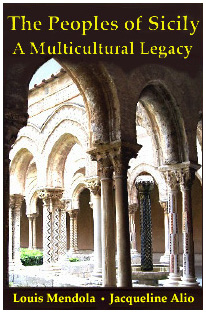
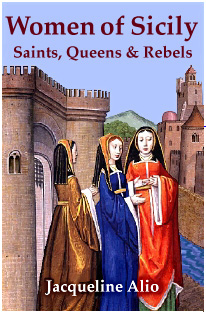
 To call them "Vikings" (Norsemen) is to oversimplify the culture of the medieval Normans, for their society, heritage
and genetic make-up were as Frankish and Roman as they were Norse. The term
"Norman" refers to the residual Norse and Frankish
civilization of Normandy. Much as the Lombards of Lombardy were not purely
Longobardic, the Normans of Normandy were not purely Norse. In fact, they
were descended not only from Vikings but from Franks,
To call them "Vikings" (Norsemen) is to oversimplify the culture of the medieval Normans, for their society, heritage
and genetic make-up were as Frankish and Roman as they were Norse. The term
"Norman" refers to the residual Norse and Frankish
civilization of Normandy. Much as the Lombards of Lombardy were not purely
Longobardic, the Normans of Normandy were not purely Norse. In fact, they
were descended not only from Vikings but from Franks, 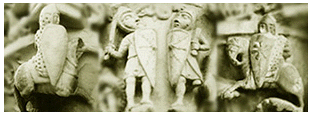 been Celtic. It fell under Roman control through the efforts
of Julius Caesar. The Franks had ruled not only in the person of Clovis,
but under the reign of Charlemagne. After 911, Charles III "the Simple"
ceded Normandy to the Norse chieftain Hrolf (Rollo), who became a Christian.
Immigration rapidly increased, and by 1000, following several generations
of intermarriage with the "native" Frankish-Celtic population
(i.e. Viking men marrying Frankish women), a distinct ethnic culture had
emerged. In the decades to follow, Norman knights arrived in Italy, first
as pilgrims and then as mercenaries, taking part (on both sides) in the
wars between Byzantines and Lombards. In some cases, these were the younger
sons of nobles who (under Frankish law) could not inherit lands destined
for eldest sons. In others, they were simply wandering men-at-arms.
been Celtic. It fell under Roman control through the efforts
of Julius Caesar. The Franks had ruled not only in the person of Clovis,
but under the reign of Charlemagne. After 911, Charles III "the Simple"
ceded Normandy to the Norse chieftain Hrolf (Rollo), who became a Christian.
Immigration rapidly increased, and by 1000, following several generations
of intermarriage with the "native" Frankish-Celtic population
(i.e. Viking men marrying Frankish women), a distinct ethnic culture had
emerged. In the decades to follow, Norman knights arrived in Italy, first
as pilgrims and then as mercenaries, taking part (on both sides) in the
wars between Byzantines and Lombards. In some cases, these were the younger
sons of nobles who (under Frankish law) could not inherit lands destined
for eldest sons. In others, they were simply wandering men-at-arms.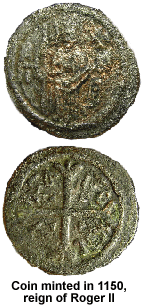 Mediterranean jewel was more important --and far wealthier--
than William's rainy realm in the North Sea; revenues from the city of Palermo
alone eclipsed those of all England.
Mediterranean jewel was more important --and far wealthier--
than William's rainy realm in the North Sea; revenues from the city of Palermo
alone eclipsed those of all England.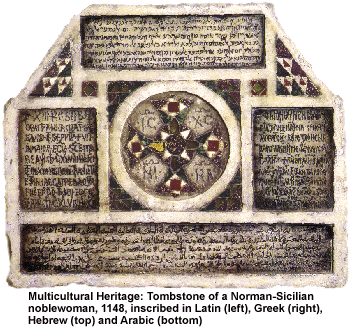 everyday sights, like
the souks (
everyday sights, like
the souks (